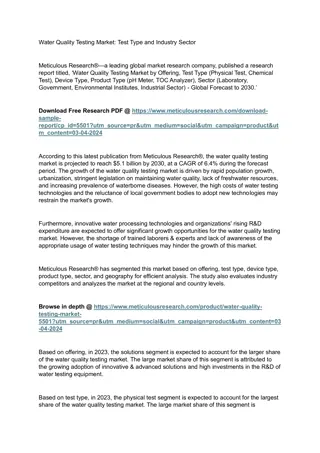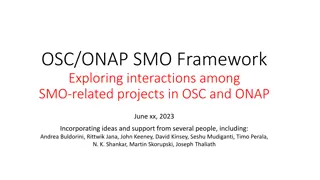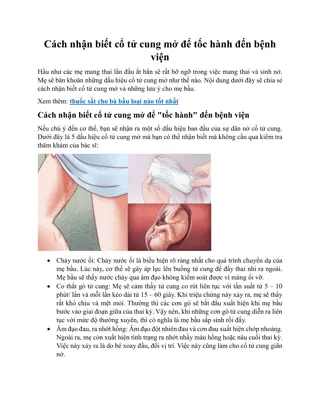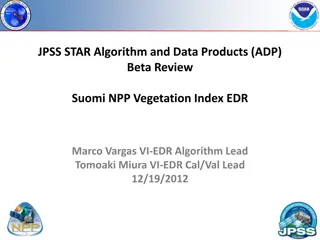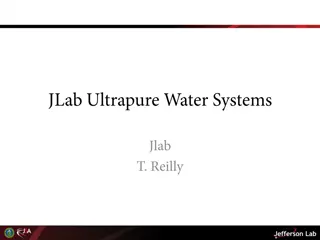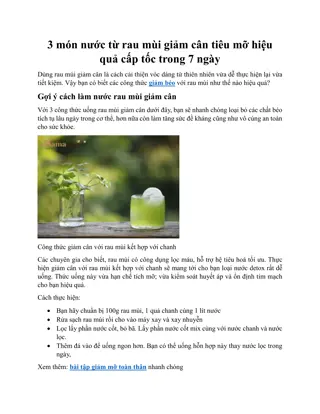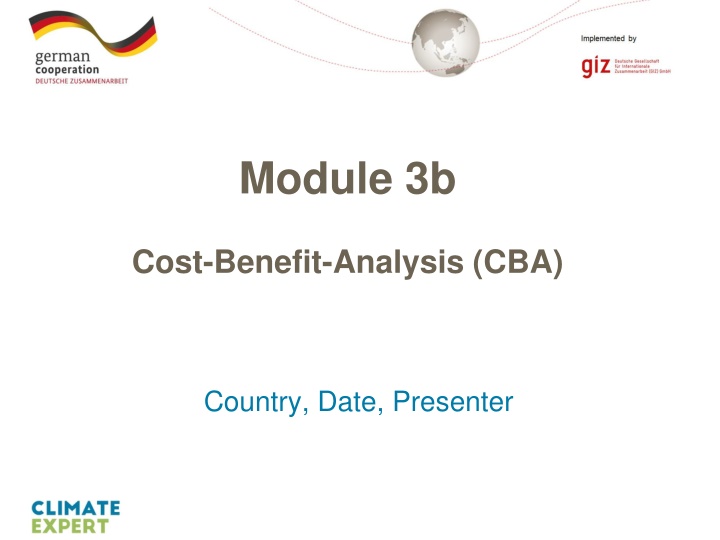
Cost-Benefit Analysis in Climate Change Adaptation
Explore the concept behind cost-benefit analysis, its application in climate change adaptation, and the challenges associated with quantifying costs and benefits. This module delves into the relevance of quantification for businesses, the systematic process of CBA, and its role in informed decision-making. Gain insights into comparing and prioritizing adaptation measures for efficient and effective decision-making in the face of climate change uncertainties.
Download Presentation

Please find below an Image/Link to download the presentation.
The content on the website is provided AS IS for your information and personal use only. It may not be sold, licensed, or shared on other websites without obtaining consent from the author. If you encounter any issues during the download, it is possible that the publisher has removed the file from their server.
You are allowed to download the files provided on this website for personal or commercial use, subject to the condition that they are used lawfully. All files are the property of their respective owners.
The content on the website is provided AS IS for your information and personal use only. It may not be sold, licensed, or shared on other websites without obtaining consent from the author.
E N D
Presentation Transcript
Module 3b Cost-Benefit-Analysis (CBA) Country, Date, Presenter Page 1
Objective The objectives of this module are to: understand the concept behind cost-benefit analysis, understand the specific approach of the cost-benefit analysis as it is used in the Climate Expert be sensitised on the short-comings of cost-benefit analysis in the context of climate change adaptation assessments ToC - Module 3b Page 2
Outline / Agenda I. Overview of Cost-Benefit Analysis II. Cost-Benefit Analysis in the Climate Expert ToC - Module 3b Page 3
I. Overview of Cost-Benefit Analysis ToC - Module 3b Page 4
I. Overview of Cost-Benefit Analysis Relevance of quantification for businesses are particularly relevant for business operations help to compare and prioritize measures support the identification of the most suitable, effective and efficient adaptation measures Support for informed decision making! ToC - Module 3b Page 5
I. Overview of Cost-Benefit Analysis Challenges of quantification Climate change and associated negatives effects that companies incur from it are uncertain costs and, particularly, benefits are not easy to quantify Not all data/information necessary for the assessment is readily available to allow for an accurate and comprehensive assessment ToC - Module 3b Page 6
I. Overview of Cost-Benefit Analysis What CBA is about CBA = Systematic process for calculating and comparing absolute costs and benefits of one or more adaptation measures Two purposes: Determining whether the project is feasible in absolute terms (Do benefits outweigh its costs?) Comparing different measures with each other (Which project achieves greater benefits? Which is most cost-effective?) ToC - Module 3b Page 7
I. Overview of Cost-Benefit Analysis What CBA is about Costs and benefits are expressed in concrete monetary terms Costs and benefits occurring at different points in time are made comparable through discounting In a business context, discounting is usually done using the market interest rate (expressing the time value of money) BUT: when it comes to climate change, the social discount rate should be used to express the inter-generational value of adaptation ToC - Module 3b Page 8
I. Overview of Cost-Benefit Analysis Limits of the CBA It needs to be kept in mind that results of CBA Offer support for decision making but are not the only information to consider no single number can decide about whether or not to implement a complex measure Are only approximations of reality they need to be interpreted and used carefully Overall, experience with conducting quantitative assessment and with interpreting results is necessary ToC - Module 3b Page 9
I. Overview of Cost-Benefit Analysis Net Present Value (NPV) Difference between discounted costs and discounted benefits of a measure over its entire lifetime. Calculated by subtracting the discounted costs from the discounted benefits. By using discounted costs and benefits the NPV accounts for the fact that costs and benefits accruing in the future are worth less today. Interpretation: If the result of the NPV is positive, the adaptation measure is economically feasible in absolute terms. The higher the NPV, the higher the net benefits of this measure. ToC - Module 3b Page 10
I. Overview of Cost-Benefit Analysis Cost-Benefit Ratio Ratio of discounted costs of the measure over the discounted benefits of the measure for its entire lifetime. It expresses how much money has to be spent in order to create one unit (in monetary terms) of benefit. Interpretation The adaptation measure is cost-effective if the CBR < 1, meaning that costs are smaller than benefits. ToC - Module 3b Page 11
I. Overview of Cost-Benefit Analysis Internal Rate of Return (IRR) Discount rate which will cause the NPV of the risk mitigation measure to equal zero Calculating the IRR relies on an iterative solution to determine what discount rate will cause the NPV of the project to equal zero. The IRR can be calculated by trial and error by varying the discount rate in the NPV formula until the NPV is equal to 0. The IRR can be used to compare different adaptation options with each other. Interpretation The higher the IRR, the greater the returns of the investment. ToC - Module 3b Page 12
I. Overview of Cost-Benefit Analysis Return on Investment (RoI) Money saved with the investment, measured in % of the total investment Calculated by dividing the NPV by the discounted costs over the entire lifetime of the investment Interpretation The higher the RoI, the higher the returns of the project in relation to the invested sum. For example: A 60% RoI means that the cost of the project and another 60% of these costs have been recovered. But: RoI is always dependent on the invested sum. A higher RoI does not necessarily mean that a measure generates more absolute savings than another measure with a lower RoI. ToC - Module 3b Page 13
I. Overview of Cost-Benefit Analysis Payback time The payback time is the time it will take for the undiscounted annual benefits to equal the initial investment costs. In other words, after how many years the company will realise net benefits. Note that you should subtract low benefits from high costs and vice versa to get the respective minimum and maximum figures ToC - Module 3b Page 14
II. Cost-Benefit Analysis in the Climate Expert ToC - Module 3b Page 15
II. Cost-Benefit Analysis in the Climate Expert Costs of adaptation measures Calculate the costs of adaptation measures, including investment and operating costs, over ten years ToC - Module 3b Page 16
II. Cost-Benefit Analysis in the Climate Expert The climate change dimension of the CBA Please note: Only relevant negative effects on the business (not relevant for opportunities) The figure of the severe climate change scenario needs to be higher than that of the baseline scenario (impacts are cummulative -> 1; 2(1+1); 3(2+1)) Title 18/03/2025 Page 17
II. Cost-Benefit Analysis in the Climate Expert The climate change dimension of the CBA What is the difference between the two scenarios? Which one is more likely? What are the implications regarding climate change adaptation? Title 18/03/2025 Page 18
II. Cost-Benefit Analysis in the Climate Expert Results How would you interpret these results? Title 18/03/2025 Page 19
Discussion Cost-Benefit Analysis Do you have experiences with Cost-Benefit Analysis? What are general challenges in implementing CBA? To what extent should you rely on the results of CBA for investment decisions? What is your view on the climate change dimension of the CBA is it practical and does it have added value for your analysis? ToC - Module 3b Page 20
Thank you for your attention! Company Company Trainer 1 Telephone number E-Mail address Trainer 2 Telephone number E-Mail address Homepage Homepage Knowledge partner ToC - Module 3b Page 21


